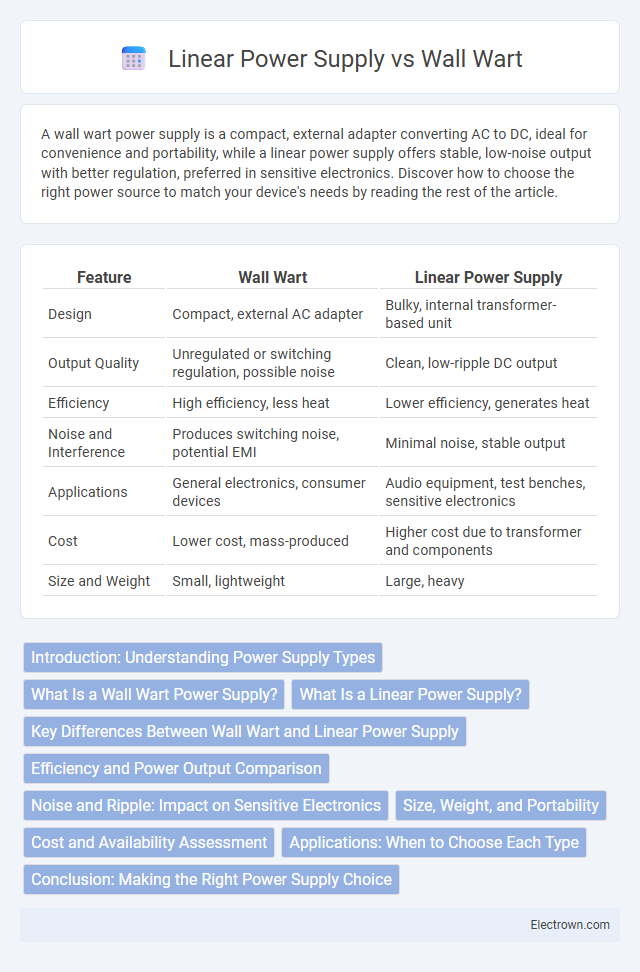A wall wart power supply is a compact, external adapter converting AC to DC, ideal for convenience and portability, while a linear power supply offers stable, low-noise output with better regulation, preferred in sensitive electronics. Discover how to choose the right power source to match your device's needs by reading the rest of the article.
Table of Comparison
| Feature | Wall Wart | Linear Power Supply |
|---|---|---|
| Design | Compact, external AC adapter | Bulky, internal transformer-based unit |
| Output Quality | Unregulated or switching regulation, possible noise | Clean, low-ripple DC output |
| Efficiency | High efficiency, less heat | Lower efficiency, generates heat |
| Noise and Interference | Produces switching noise, potential EMI | Minimal noise, stable output |
| Applications | General electronics, consumer devices | Audio equipment, test benches, sensitive electronics |
| Cost | Lower cost, mass-produced | Higher cost due to transformer and components |
| Size and Weight | Small, lightweight | Large, heavy |
Introduction: Understanding Power Supply Types
Wall wart power supplies are compact, external adapters typically used for low-power devices, converting mains AC to a regulated DC output. Linear power supplies provide stable and low-noise power by using a transformer, rectifier, and regulator, often preferred in audio and sensitive electronics due to their clean output. Choosing between the two depends on factors like efficiency, size, cost, and noise sensitivity in the application.
What Is a Wall Wart Power Supply?
A wall wart power supply is a compact, external transformer that plugs directly into an electrical outlet to convert high-voltage AC power into lower-voltage DC power for electronic devices. These units often feature integrated circuits for voltage regulation and are widely used for powering small appliances like routers, modems, and portable electronics. Compared to linear power supplies, wall warts offer convenience and portability but may generate more electrical noise affecting sensitive equipment.
What Is a Linear Power Supply?
A linear power supply converts high voltage AC into a lower voltage DC using a transformer, rectifier, and regulator, providing stable and low-noise output ideal for sensitive electronic devices. Unlike wall warts, which are compact switching power supplies prone to electromagnetic interference, linear power supplies are larger but offer superior signal purity due to their simple design and continuous regulation. This makes linear power supplies preferred in audio equipment, laboratory instruments, and radio communications for consistent, clean power delivery.
Key Differences Between Wall Wart and Linear Power Supply
Wall warts are compact, external AC/DC adapters that convert mains voltage to low-voltage DC, often featuring integrated transformers and switching circuits, ideal for portability and convenience. Linear power supplies utilize a large transformer and linear regulation inside the device, providing cleaner, noise-free DC output with superior voltage stability but generating more heat and bulk. The key differences lie in size, efficiency, output noise, and application suitability, where wall warts excel in compactness while linear supplies prioritize performance and low ripple for sensitive electronics.
Efficiency and Power Output Comparison
Linear power supplies typically offer cleaner, more stable voltage outputs but operate with lower efficiency due to heat dissipation, often around 30-60%. Wall warts, especially switch-mode variants, achieve higher efficiency levels ranging from 70% to over 90%, resulting in less energy loss and reduced heat generation. When selecting a power solution, your choice should balance the need for power output quality against efficiency demands, with wall warts favored for compact, energy-conscious applications and linear supplies preferred for sensitive analog circuits requiring minimal noise.
Noise and Ripple: Impact on Sensitive Electronics
Wall wart power supplies often generate higher noise and ripple compared to linear power supplies, which can introduce unwanted interference in sensitive electronics. Linear power supplies provide cleaner, more stable voltage with minimal ripple, making them ideal for audio equipment, measurement devices, and precision circuits. Ensuring your device receives power with low noise and ripple helps maintain optimal performance and reduces the risk of signal degradation.
Size, Weight, and Portability
Wall warts are compact, lightweight external power adapters that plug directly into an outlet, making them highly portable and space-efficient for on-the-go use. Linear power supplies are typically larger and heavier due to their bulky transformers and metal enclosures, limiting their portability and requiring more dedicated space. For applications prioritizing minimal size and easy transport, wall warts offer a significant advantage over traditional linear power supplies.
Cost and Availability Assessment
Wall warts generally offer a cost-effective and widely available power solution, benefiting from mass production and compact design that reduce expenses. Linear power supplies, while often more expensive due to higher-quality components and better voltage regulation, provide reliable performance with minimal electrical noise. The availability of wall warts is extensive across consumer electronics stores and online platforms, whereas linear power supplies may require specialized vendors or custom orders, impacting accessibility.
Applications: When to Choose Each Type
Wall wart power supplies are ideal for low-power applications like charging small electronics, providing convenience and portability. Linear power supplies excel in audio equipment or sensitive instrumentation where low noise and stable voltage are critical. Your choice depends on balancing compactness and efficiency with noise performance and regulation needs.
Conclusion: Making the Right Power Supply Choice
Choosing between a wall wart and a linear power supply depends primarily on your device's power stability needs and noise sensitivity. Wall warts are compact and cost-effective but may introduce electrical noise, while linear power supplies deliver cleaner, more stable output ideal for sensitive audio or measurement equipment. Assess your project's specific voltage requirements and noise tolerance to ensure your power supply choice optimizes performance and reliability.
wall wart vs linear power supply Infographic

 electrown.com
electrown.com